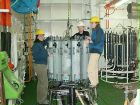3/16/03 9:00 am local time 1300 GMT lat: 63 40.334S long: 61 11.323W
We finally reached the Antarctic Peninsula last night around 5 p.m. Our first series of research stations were in Admiralty Bay on the southeastern side of King George Island. Here, we deployed three CTDTs (Conductvity-measures salinity, Temperature, Depth, Transmissivity-measures concentration of particulate matter) in order to find sediment plumes. If the downward readings indicated the presence of a sediment plume, water samples at a series of depths were collected as the instrument was brought back to the surface. Hopefully this would allow us to gain more information about the distribution of suspended sediment within the plume. These samples were sheltered from light exposure and will be used to date the plume by determining when the grains were last exposed to light. Presently we are in transit (24 hours) to Palmer Station on Anvers Island. Palmer is a major U.S. research station that operates year-round. Many scientists and support staff will disembark the Gould here to spend the austral winter working at Palmer Station.
Emily and Sarah Doane
- Sarah Doane: Sarah.Doane@lmg.usap.gov
- Emily Constantine: Emily.Constatine@lmg.usap.gov
Sunday, March 16, 2003
Yesterday evening we arrived at Admiralty Bay to collect suspension samples. The first two stations within the bay did not provide enough sediment, but we had a little more luck with the third, even though it was dark (9 p.m. locally) during this operation. Now we let the sediment settle out (providing we continue to have a smooth passage) until we have a small enough volume to transport home for analysis. Today we're on our way to Palmer Station to drop off supplies and people. We saw more humpback whales this morning - very impressive! We're also in view of the Antarctic Peninsula, which is some of the most striking landscape I've seen so far. The jagged mountains are covered in snow and ice, which almost glow when the sun shines down through the clouds. Beautiful, but definitely not very hospitable. I'm glad I'm here now and not 100 years ago! More to come on our adventure. . . . sara
(from left to right) Emily Constantine from Colgate, Randy Dirszowsky from Queen's University and Sara Doane from Hamilton prepare a rosette of sampling bottles to collect sediment-laden water at depth. The bottles are prepared with both ends open as can be seen on the one in front of Sara. As the device is lowered into the water, water flows through the bottles unimpeded. Instruments in the protective cage below the bottles record transmissivity, depth and salinity of the water and send this information back to computers on the ship via the yellow/black cable at the top of the rosette. Sediment laden water is characterized by low transmissivity due to the large amount of suspended material in the water. All or individual bottles may be closed by a signal sent from the ship. This allows water to be collected from various depths without cross contamination. This prep work is being done in the Baltic Room of the Gould. The large door directly behind the rosette opens allowing direct access to the ocean, 5 to 6 feet below.
Sara Draucker, Desert Research Institute
Please contact Sara Draucker: Sara.Draucker@lmg.usap.gov

